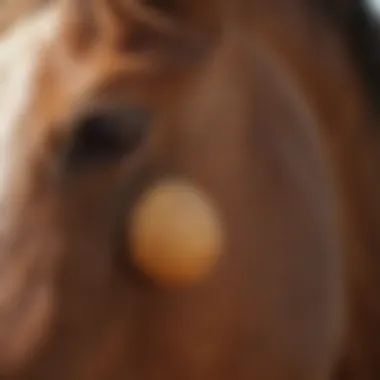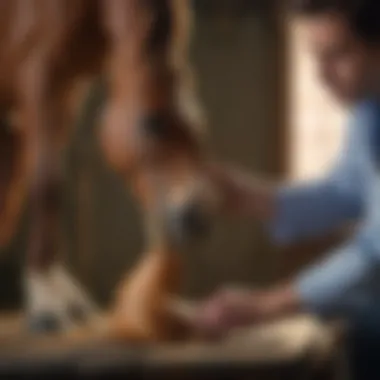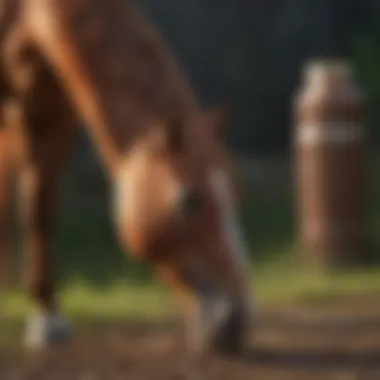Effective Treatments and Management for Horse Thrush


Intro
When it comes to managing equine health, one condition often rears its head, particularly in the moist environments where many horses find themselves: thrush. This troublesome hoof condition poses not only a nuisance but also serious health risks if left unchecked. Understanding thrush means recognizing an interplay of various factors that contribute to its development - from hygiene practices to environmental influences.
Thrush is mainly caused by a bacterial infection that thrives in damp, unsanitary conditions, particularly in the sulci of the frog - that V-shaped structure on the horse’s hoof. Horse owners and caretakers need to know the importance of not just treating the symptoms, but addressing the root causes. With proper awareness, one can prevent thrush effectively and maintain optimal hoof health.
In the following sections, we will delve into key concepts, recent trends, and practical techniques for treating thrush, providing a comprehensive toolkit for livestock enthusiasts and farmers alike.
Understanding Thrush in Horses
Understanding thrush in horses is fundamental not just for the well-being of the horse itself but for the stability and success of a horse owner’s operation. Thrush (a bacterial infection) is often misinterpreted at first glance because its appearance can be mistaken for other hoof disorders. Ignoring the signs can lead to severe consequences, including chronic pain and, if left untreated, possible lameness. Awareness around this issue enables owners to act quickly and effectively.
Definition and Causes
Thrush is a disease of the hoof that triggers a bacterial infection in the frog, often producing a foul smell and dark discharge. It's commonly caused by inadequate hoof care, moist conditions, and poor stable hygiene. Conditions where horses stand in wet or dirty environments favor the growth of pathogens. Owners should recognize that a muddy pasture or a damp stall can lead to an outbreak of thrush.
Symptoms and Diagnosis
The ability to identify thrush early on hinges on recognizing various symptoms, which can manifest both visually and behaviorally.
Visual Signs
Visual signs are the most immediate indicators of thrush. When inspecting the hooves, one might notice black, smelly discharge between the frog and heel bulbs. A key characteristic to look out for is the unusual texture of the frog, which often appears different—sometimes it looks softer or even starts to separate from the hoof wall. Frequent visual inspections enable owners to catch the condition before it escalates. However, it is important to note that not all horses will show the same signs, highlighting the need for regular checks.
Behavioral Indicators
Behavioral changes in horses can also signal thrush, as discomfort can lead to altered movements. Horses may become hesitant to walk, particularly on uneven ground. Key to this is the observation that a horse might frequently lift one of its hooves unprompted or stand awkwardly. It is a beneficial choice for horse owners to be vigilant about their animal's regular behavior. If behaviors seem out of the ordinary, an underlying hoof issue might be the cause. In this regard, consistent monitoring can play a crucial role in early diagnosis.
Veterinary Assessment
Consulting a veterinarian is vital, especially if thrush is suspected but cannot be confirmed through physical inspection. Their expertise will often involve a holistic assessment of the hoof and an examination of the horse's overall health. A key feature of veterinary assessment is the ability to differentiate thrush from more severe issues like laminitis or abscesses. The advantages of leveraging this expert opinion are immense, as they can also provide tailored treatment plans that consider the horse's individual needs, ensuring a more comprehensive road to recovery.
"Preventing thrush isn't just about maintaining the horse’s hooves; it reflects a broader commitment to the animal's health and future performance."
In summary, understanding thrush equips horse owners with the necessary knowledge to manage this condition proactively. By being aware of the definition, causes, and symptoms, they are better positioned to maintain the hoof health of their beloved equine companions.
The Importance of Hoof Care
Caring for a horse’s hooves goes beyond mere aesthetics; it is a cornerstone of overall equine health and wellbeing. Each horse radiates a unique personality, much like we do, and just like we are affected by our own physical conditions, horses can suffer when their hooves are neglected. Healthy hooves provide the foundation for a horse's movement, agility, and strength, ultimately affecting performance and quality of life.
Maintaining hoof care effectively can help prevent common ailments, including thrush, which can be a real bother if not addressed promptly. Think of it this way: just as the saying goes, "A chain is only as strong as its weakest link," a horse relies on its hooves to bear and balance its entire body. If hoof care is overlooked, trouble can follow.
Regular hoof care involves both physical maintenance—like trimming and cleaning�—and environmental considerations. Without proper hoof maintenance, even the most resilient horses may succumb to conditions that hinder their mobility. It's an ongoing responsibility, reflecting a deep commitment from horse owners to ensure their equine companions are healthy and happy.
Role of Regular Hoof Maintenance
Regular hoof maintenance serves as the first line of defense against thrush and other hoof problems. This practice includes consistent inspections, cleaning, and necessary trimming. Horses spend most of their lives standing and moving on various surfaces, accumulating debris and dirt in their hooves. Ignoring daily hoof checks amounts to leaving a door wide open for infections.


By consistently maintaining hooves, owners enable early detection of any irregularities that might lead to major issues down the road. A simple trim every few weeks maintains balance and prevents problems related to overgrown hoof walls and soles. Essentially, routine maintenance is not just a chore; it’s a proactive approach to securing your horse's overall health. The old saying, "An ounce of prevention is worth a pound of cure" certainly applies here.
Environmental Influences on Hoof Health
Ensuring that horses live in a stable, clean environment is just as pivotal for hoof health as physical maintenance. Various environmental factors contribute significantly to the condition of a horse’s hooves, particularly moisture levels, bedding type, and pasture management.
Moisture Levels
Moisture levels play a crucial role in hoof health. Horses that graze in wet, muddy pastures may experience soft hoof soles, which can lead to various side effects, including thrush. It’s a delicate balance; while some moisture is essential to maintain hoof flexibility, excessive dampness can create a breeding ground for bacteria. Moisture can also compromise the integrity of the hoof wall, eventually leading to cracks or other complications. Monitoring and managing moisture levels is vital for prevention, making it a beneficial focus for any horse-owner.
Type of Bedding
The type of bedding used in stables can have a profound impact on hoof health. Choosing the right bedding not only affects comfort but also helps in managing moisture. For instance, straw can absorb moisture and leave residual dampness, while shavings tend to be better at keeping the environment dry. Proper bedding reduces the risks of thrush by creating a barrier against dampness. Good bedding practices are critical in preventing infections and maintaining hoof health; it can be the difference between a happy horse and one struggling with hoof problems.
Pasture Management
Pasture management is another element that can never be sidelined. It involves more than just letting your horse roam free; it requires careful planning and care. Ensuring pastures are not overgrazed and providing rotational grazing helps the land recover. Keeping hooves healthy means minimizing exposure to muddy areas, especially during wet conditions. Routine checks of pastures contribute to more resilient hooves and overall better hoof health. Pasture management reflects a good stewardship practice that not only benefits individual horses but also the land they're on.
Common Treatment Options for Thrush
Addressing thrush effectively is crucial not just for the comfort of the horse but also for ensuring a long-term solution to hoof health. When horses are sidelined by this ailment, it can lead to further complications. Treatment approaches vary widely, but understanding each option is key for horse owners seeking the best care for their equine companions. The importance of these treatments lies not just in eradicating the infection but in returning the horse to optimal performance levels while also enhancing overall hoof care practices.
Topical Antiseptics
Topical antiseptics are often the first line of defense against thrush. These solutions are designed to kill the bacteria that contribute to the hoof infection. Widely used antiseptics include iodine-based solutions and silver sulfadiazine, which can be quite effective. When applying these substances, it is crucial to first clean the hoof thoroughly to remove any debris or necrotic tissue. The antiseptic should be applied directly to the affected areas, allowing for maximum absorption.
Proper application can make all the difference in resolving the infection before it worsens.
While topical antiseptics may work wonders in many cases, it's worth noting that their effectiveness can vary based on the severity of the thrush. Some horses might not respond immediately, leading the owner to reconsider treatment or add in other options.
Medicated Hoof Pastes
Medicated hoof pastes represent another valuable treatment alternative. These pastes often combine antifungal and antibacterial agents. They are easy to apply and provide prolonged contact with the hoof, which can be beneficial for more stubborn cases. Pastes such as Thrush Buster or Hooflex are specifically formulated to penetrate the hoof wall and combat the bacteria lurking there.
Consistency is key when using these pastes. Regular application is recommended until the thrush is entirely resolved. They can also help in maintaining hoof moisture levels, which sometimes decrease as an effect of thrush treatment.
While these products may offer relief, some pastes can be somewhat thick, making it tricky to apply evenly. Ensuring that the entire affected area is covered can be a challenge, especially if the horse is restless during treatment application.
Veterinary Interventions
In cases where thrush persists despite at-home treatments, veterinary intervention may become necessary. This can involve various strategies tailored to the specific horse’s needs.
Surgical Options
Surgical options for thrush treatment are less common and generally reserved for severe cases where necrotic tissue needs to be removed. The process entails a veterinarian cleaning the affected area and may involve minor surgery to ensure complete eradication of the infection. This approach is beneficial due to its thoroughness; once the dead tissue is cleared, healing can occur more efficiently.
A key characteristic of surgical treatment is its decisiveness. Unlike topical solutions that might only offer partial relief, surgery can often provide a permanent fix. However, it does come with the risk of complications, like infection or a longer recovery time. Horse owners should weigh these factors carefully before pursuing this route, considering their horse's temperament and the potential stress the procedure may induce.


Systemic Treatments
Systemic treatments typically involve administering antibiotics or anti-inflammatory medications. These treatments can effectively combat any underlying infections that might not respond to topical medications. The primary advantage of systemic treatment is that it targets the issue from within, potentially providing more comprehensive results. However, one must also consider the risk of antibiotic resistance and the need for a veterinarian's guidance in choosing the correct medication and determining the right dosage.
The choice of systemic treatments may initially seem like a straightforward fix but can involve complications such as side effects or requiring ongoing monitoring. This highlights the importance of collaborating with a knowledgeable veterinarian to ensure that the approach taken is not only effective but also safe for the horse.
In summary, addressing thrush in horses effectively requires a tailored approach. From topical antiseptics to medications and even surgery, understanding each option's advantages and limits is pivotal. This layered understanding ensures that horse owners are well-equipped to combat this ailment holistically.
Preventative Measures for Thrush
Preventing thrush in horses is about more than just treating the condition when it arises. It involves understanding the environment in which the horse lives and the overall management practices undertaken by the owner. Correct preventative measures can greatly reduce the likelihood of thrush developing, ensuring that hooves remain healthy and free from infection. This proactive approach saves time, money, and discomfort not only for the horse but also for the horse owner.
Improving Stabling Practices
Drying Techniques
Drying techniques in stabling practices are crucial in preventing thrush. Moist environments are a breeding ground for Fusobacterium necrophorum, the bacterium that causes thrush. Therefore, maintaining dry living conditions plays a significant role in stopping bacteria from flourishing. Key characteristics of effective drying techniques include proper drainage and good airflow within the stable. One beneficial practice is to ensure that bedding is changed regularly and that wet spots are dried promptly. A dry stable helps in eliminating excess moisture, which forms the perfect habitat for thrush.
However, the unique feature of these drying techniques lies in their adaptability. Depending on local conditions, horse owners can implement strategies such as using fans to improve ventilation or investing in moisture-wicking bedding materials. While these options may come with initial costs, the long-term advantages greatly outweigh them – reduced vet bills and a healthier horse being paramount.
Hygiene Protocols
Hygiene protocols form the backbone of preventing thrush in a horse's living environment. The cornerstone of these practices is cleanliness. Regularly cleaning the stable and the horses' hooves can mitigate the risk of bacteria taking hold. Key aspects of hygiene protocols include disinfecting surfaces, removing manure promptly, and ensuring that water sources are uncontaminated. This commitment to a clean environment does wonders in warding off infections.
Furthermore, hygiene protocols can be tailored according to the needs of the specific yard. For example, boarding stables may require more frequent sanitation measures than a smaller private barn simply due to horse density. A unique feature of hygiene practices involves the use of natural disinfectants. Not only are they effective, but they can also be less harmful to both the horses and the environment. However, a downside is that some may find these methods less potent compared to chemical alternatives.
Routine Hoof Inspection
Routine hoof inspection is a necessary practice that goes hand in hand with preventive measures. Checking the hooves regularly allows horse owners to catch early signs of thrush before they escalate. During inspections, look for signs of abnormal odor, discoloration, or any abnormal structural changes in the hoof. Regular inspections also allow owners to develop an understanding of their horse’s hoof health over time.
Establishing a consistent schedule for hoof checks — whether it’s weekly or biweekly — provides opportunities for owners to notice changes and act on them. Not only does this keep the hooves in better shape, but it also strengthens the owner-horse bond, which is essential in assessed upbringing.
Nutritional Support
Role of Minerals
The role of minerals in a horse's diet cannot be understated when considering thrush prevention. Key minerals such as zinc and copper contribute to strong, healthy hooves. These essential nutrients play significant roles in keratin production, the protein that makes up hoof horn. Without adequate amounts of these minerals, a horse's hooves are more prone to weakness, increasing the risk of conditions like thrush.
What makes minerals particularly beneficial is their ability to tackle underlying deficiencies that may lead to hoof problems. When horse owners incorporate a balanced equine diet rich in minerals, they're not just preventing thrush— they’re boosting the overall hoof integrity. However, it's essential for owners to consult equine nutritionists or veterinarians before making dietary adjustments, as imbalances can also occur.
Dietary Adjustments
Dietary adjustments can significantly enhance the overall hoof health and combat the risk of thrush. A focus on high-quality forage and targeted supplements can make a huge difference. For instance, switching to a more fibrous forage can improve digestive health, leading to better nutrient absorption. Moreover, reducing the consumption of sugary feeds can also lead to fewer hoof problems.
Unique features in dietary adjustments include the introduction of biotin supplements, known for promoting hoof growth and quality. Alternatively, increasing omega-3 fatty acids can help reduce inflammation and improve overall hoof health. Each horse is unique, however, so it’s crucial to observe how new diets impact the horse over time, as certain adjustments may yield more noticeable improvements than others.
Regular monitoring and adjustments in both the environmental and dietary factors create a leveled field against thrush development, leading to happier and healthier equine companions.


Understanding Thrush Recurrence
Thrush can be quite the headache for horse owners. Recognizing its tendency to return is essential for maintaining equine hoof health. Because thrush is more than a mere inconvenience; it can lead to more serious issues if not managed properly. Exploring thrush recurrence not only gives owners insight into their horse’s health but also equips them with knowledge to tackle these recurrent problems head-on. Understanding the factors that contribute to recurring thrush helps shape effective long-term strategies and interventions.
Factors Leading to Recurring Thrush
Geographic Considerations
Geography plays a significant role in thrush recurrence. Different regions have distinct climates, impacting moisture levels and humidity, which directly affect hoof health. For instance, horses in wet, swampy areas often face higher risks. The persistent wetness promotes bacterial growth, giving thrush a fighting chance. In contrast, horses living in drier regions may find hoof infections less common. This distinction is key; knowing your area helps to prevent conditions favorable for thrush. Understanding local weather patterns, such as rainy seasons, can help horse owners prepare to take extra precautions during those times.
Another characteristic is the type of soil prevalent in an area. Sandy soils could drain better, while clay retains moisture more. This drainage difference is essential in horse care, as higher moisture keeps bacteria alive and on the offensive, ready to attack a horse’s hooves. Thus, this geographic nuance is crucial in understanding thrush's persistent nature.
Underlying Health Issues
There are contributing factors in the horse itself that can cause thrush to return. Horses with compromised immune systems or pre-existing hoof issues may often struggle with repeated bouts of thrush. Essentially, if a horse is predisposed to various health issues, it becomes a weak link in the fight against thrush. Changes in diet, infections, or even genetic factors can lower a horse’s immunity. Taking stock of these underlying health concerns allows owners to see a broader picture of hoof care.
A unique aspect here is understanding hoof conformation. Horses with poorly shaped hooves might trap moisture, creating an ideal breeding ground for thrush. Thus, poor hoof structure becomes not just a concern but a pivotal factor leading to recurrent thrush. If owners ignore these underlying health issues, they might find themselves in a constant battle against thrush.
Long-term Management Strategies
Tracking Hoof Health
Keeping a close eye on hoof conditions is paramount in preventing thrush from becoming an unwelcome guest. This means regular visual checks and documentation. As the saying goes, "a stitch in time saves nine." By tracking changes in hoof health, owners can catch any abnormalities early, before they spiral into serious issues. Creating a specific hoof care routine is beneficial—schedule checks every few weeks and maintain records.
A unique feature here is leveraging technology. Nowadays, many applications keep track of a horse’s hoof health, enabling owners to set reminders for checks and treatments. The benefit is two-fold: vigilance and prevention. Recognizing signs of thrush early—discoloration, smell, or lifting of the frog—can save time, money, and stress in the long run.
Adjusting Care Practices
Adjusting care practices is a cornerstone of effective thrush management. Every horse is unique, and what works for one may not cut it for another. Key characteristics of adjusting care practices include varying hoof cleaning routines, exploring different bedding options, and frequently altering stabling conditions. Each of these measures contributes to reducing moisture levels, which are pivotal in thrush prevention.
A unique aspect of this approach is flexibility. For example, horse owners might have to switch bedding materials during rainy seasons or plan stabling based on anticipated weather patterns. Such adaptability not only keeps hooves dry but also engages owners actively in their horse’s care. Rethinking daily habits is a simple yet effective way to mitigate the recurring nature of thrush, ensuring healthier hooves overall.
Keeping in mind the various factors at play—geographic location, underlying health issues, tracking health, and completing care adjustments— will ultimately set the stage for a more robust preventive strategy against thrush in horses.
Closure
In wrapping up the discussion surrounding thrush in horses, it is vital to recognize the immense significance of this topic not just for the wellbeing of individual horses, but for the overall health management in equine care. Thrush remains a persistent threat that can cause serious complications if left unchecked. Therefore, understanding the intricacies of prevention, identification, and treatment is indispensable for any horse owner or caregiver.
In this article, we delved into several grassroot factors influencing thrush, covering everything from environmental considerations to nutritional support. By emphasizing a holistic management approach, we highlighted how vigilant hoof care and attention to the horse’s living conditions are paramount. Each horse is unique; thus, tailored solutions will often yield the best outcomes.
Furthermore, one must consider the relationship between hoof health and systemic issues, including underlying illnesses and behavioral patterns. Through diligent observation and adaptation of care practices, horse owners can significantly reduce the likelihood of thrush reoccurring.
"Prevention is always better than cure." This adage rings particularly true in the context of thrush management. Both proactive and reactive strategies need to be finely balanced.
As horse owners become increasingly aware of their vital role in maintaining hoof health, it's clear that well-informed practices can foster not just recovery from thrush but also prevent future outbreaks. In emphasizing education and precise action, we pave the way for healthier, happier horses.
Summary of Key Points
- Thrush is a bacterial infection that affects equine hoofs, often occurring in moist environments.
- Key symptoms include discoloration, foul odor, and sensitivity in the affected area; behavioral changes can also signal discomfort.
- Regular hoof care—including cleaning and inspections—is crucial in preventing thrush.
- Environmental management, including bedding choices and moisture control, directly influences thrush incidence.
- Prompt treatment options, such as topical antiseptics and hoof pastes, can support effective recovery.
- Long-term management strategies involve continuous monitoring and adjusting care based on specific horse needs.
Future Considerations for Horse Owners
- Educate yourself: Stay informed about the latest practices in hoof care and treatment options. Workshops, seminars, or online resources play a crucial role in enhancing your knowledge.
- Environmental Management: Focus on optimizing stable conditions. This includes dry bedding, proper drainage, and adequate space—making it less prone to thrush.
- Regular Veterinary Consultations: Establish a routine for professional hoof assessments. Regular check-ups can identify early symptoms of thrush or underlying issues.
- Community Engagement: Join forums and groups with fellow horse owners. Sharing experiences and tips can provide new solutions or techniques in managing hoof health.
- Tailored Nutritional Plans: Work with a veterinarian or equine nutritionist to customize diet plans that reinforce overall health and hoof resilience.















